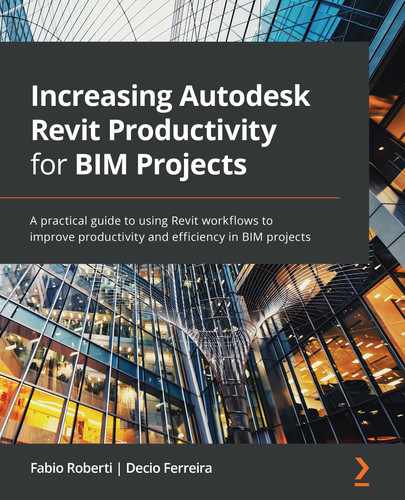Discover how to implement Revit best practices along with Dynamo and Power BI to visualize and analyze BIM information Revit software helps architects, BIM coordinators, and BIM managers to create BIM models and analyze data to improve design and construction. Building Information Modeling (BIM) has promoted a transformation in the engineering and construction industries where information is at the core of a methodology that improves productivity, providing several benefits in comparison to the traditional 2D CAD process. This book takes a hands-on approach to implementing this new methodology effectively. Complete with step-by-step explanations of essential concepts and practical examples, this Revit book begins by explaining the principles of productivity in Revit and data management for BIM projects. You'll get to grips with the primary BIM documentation to start a BIM project, including the contract, Exchange Information Requirements (EIR), and BIM Execution Plan (BEP/BXP). Later, you'll create a Revit template, start a Revit project, and explore the core functionalities of Revit to increase productivity. Once you've built the foundation, you'll learn about Revit plugins and use Dynamo for visual programming and Power BI for analyzing BIM information. By the end of this book, you'll have a solid understanding of Revit as construction and design software, how to increase productivity in Revit, and how to apply multiple workflows in your project to manage BIM. This book is for architects, designers, engineers, modelers, BIM coordinators, and BIM managers interested in learning Autodesk Revit best practices. Increasing Autodesk Revit Productivity for BIM Projects will help you to explore the methodology that combines information management and research for quality inputs when working in Revit.Key Features
Book Description
What you will learn
Who this book is for
Table of Contents
- Increasing Autodesk Revit Productivity for BIM Projects
- Contributors
- About the authors
- About the reviewer
- Preface
- Section 1: Enhancing Your Productivity in Revit with Data Management and Templates
- Chapter 1: Introduction to Productivity in Revit
- What you should know about Revit productivity
- Computer maintenance
- Always use the same Revit update release
- Revit's recommended settings
- File size
- Family creation
- Model groups
- In-place families
- Arrays
- Constraints
- When using a worksharing environment
- Splash screen
- Choosing the right tool
- What is the best workstation for Revit?
- Desktop or laptop?
- A fast processor
- The best graphics card
- Computer memory (RAM)
- A fast hard drive
- Overview of BIM implementation
- BIM and the Revit training scheme
- Assessing staff knowledge
- Identifying the current training process
- Determining the training obstacles
- Defining the training budget
- Identifying in-house experts
- Establishing a process to measure progress
- Identifying resources
- Training customization
- Summary
- Chapter 2: Project Data Management
- Critical data to start a BIM project
- Appointment or Contract
- Exchange Information Requirements (EIR)
- BIM Execution Plan (BEP)
- BIM Execution Plan (BEP) – Pre-contract
- BIM Execution Plan (BEP) – Post-contract
- Digital data to start a project
- BIM documentation overview
- Client documents
- Project team documents
- BIM standards and guidance
- Project functions
- Appointing Party (Client)
- Task Team Manager
- Task Information Manager
- Information authors
- Interface managers
- Information Management
- AEC UK BIM Protocol
- Strategic – BIM Management
- Management – Coordination
- Production – Modeling/Authoring
- Asset Management
- COBie
- Interview with George Stevenson, Managing Director at ActivePLAN
- Establishing an Action Plan to start a BIM project
- Action Plan to manage project data
- Summary
- Chapter 3: Revit Template and Standards
- Section 2: Setting Up Revit Projects Efficiently and Exploring Core Functionalities
- Chapter 4: Starting a Revit Project Efficiently
- Chapter 5: Core Revit Functionalities
- Understanding schedule management
- Basic Workflow
- Advanced Workflow
- Keynote for the project specification
- Keynote types
- Annotating drawings with Keynote
- Design Options
- Revit Phasing
- Phase Filters
- Phase – Graphic Overrides
- Displaying multiple phases from Linked files
- Using Scope Boxes
- Rotating a Scope Box
- Worksharing
- How to create a Revit Central file
- How to create a Revit Local file
- Best practices for Worksharing
- Drawing production
- Summary
- Section 3: Adding Visualizations and Dashboards to Your Data
- Chapter 6: Visual Programming with Dynamo
- Chapter 7: Dashboard Analyses with Power BI
- Technical requirements
- Introduction to Power BI for Revit
- Installing Microsoft Power BI Desktop
- Starting Microsoft Power BI
- Working with Microsoft Power BI
- Exporting and importing data from Revit to Power BI
- Connecting Revit to Power BI: An introduction to visualizing model data
- Analyzing Revit data with Power BI
- Analyzing Revit data with useful workflows in Power BI
- Summary
- Section 4: Collaborating with Consultants and Plugins and Improving Revit Performance
- Chapter 8: Collaborating with Consultants
- Chapter 9: Enhancing Productivity with Plugins
- Chapter 10: Improving Performance
- Revit modeling best practices
- CAD import best practices
- Views and sheet management
- Modeling
- Revit content management
- Third-party families
- Overmodeling families
- CAD formats imported into families
- Avoiding complex shape modeling
- Defining element visibility settings
- Flexing families
- Optimizing Revit's performance
- Keyboard shortcuts
- Warnings
- Compacting a Revit file
- Auditing a Revit file
- Disabling plugins in Revit
- BIM 360 best practices
- Summary
- Hey!
- Why subscribe?
- Other Books You May Enjoy
